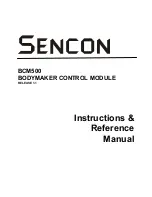
©
2012 Sencon Incorporated
Page 1
BCM500/387 Bodymaker System
BCM500: DESCRIPTION
ALUMINUM-ON-PUNCH BODYMAKER SENSOR SYSTEM
The Aluminum-on-Punch Bodymaker Sensor System detects the presence of wall-ironed aluminum on the
forming punch of a bodymaker. The system is made up of a specialty sensor, the 387, and a control module,
the BCM500. The system automatically compensates for the magnetic properties of the punch and mounting
hardware, eliminating the need for a different sensor for each punch composition. This also eliminates
problems associated with magnetic variations attributed to carbide batch tolerances, and minimizes the effect
of variations due to temperature. The system profiles the punch, which allows the sensor to accurately detect
tearoffs and short cans before the punch is fully extended, thus providing more time to stop the machine. The
Sensor System detects aluminum over a variety of punch materials, making it ideal for plants changing from
one punch type to another.
The Bodymaker Sensor System offers two modes for stopping the bodymaker, immediate stop and timed
stop. The immediate stop mode stops the machine when a can defect is detected. The module immediately
opens two transistor switches that can interrupt 2 Amperes at 24 Volts when a defect is detected. The timed
stop mode synchronizes stopping the machine with the leading edge of the backstop window.
The Bodymaker Sensor System is not applied the same way a typical absence/presence proximity sensor is
applied. The machine control logic must be altered to do the calibration function of the sensor. This allows
the sensor to calibrate to the punch material and to profile the punch. Four or more dry strokes (machine
strokes without cans in process) are required to calibrate the sensor.
The BCM500 expands the capabilities of the 387-S1 Bodymaker Sensor System. The module supports the
original short can and tearoff detection and supports dome jam detection and the airstrip function. The 387
sensor design is enhanced with extended calibration capabilities. The sensor now works with ceramic
punches that have steel nose pieces. The sensor also maintains calibration information internally in
EEPROM, eliminating the need to recalibrate every time the power to the sensor cycles.
The 9H-387 sensor has an integral cable and the 11H-387 sensor is terminated using a quick disconnect
cable. A hose fitting designed to accept 0.75" I.D. [19.1 mm] hydraulic tubing surrounds the connector. Use a
stainless steel hose clamp to provide a positive mechanical and hydraulic seal of the hose to the fitting. This
aids in shielding the sensor and connector from the bodymaker coolant.
Sensors other than a 387 can be used with the BCM500. Consult the factory for applications where the
BCM500 is to be used with existing Sencon 287 style bodymaker sensors.

















